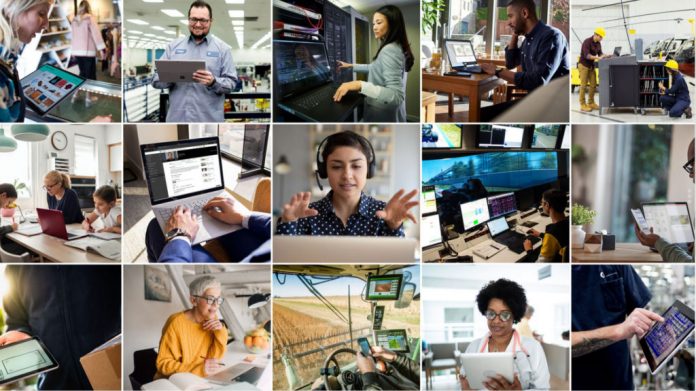Jun 30, 2020 | Brad Smith – President & Vice Chair
Around the world, 2020 has emerged as one of the most challenging years in many of our lifetimes. In six months, the world has endured multiple challenges, including a pandemic that has spurred a global economic crisis. As societies reopen, it’s apparent that the economy in July will not be what it was in January. Increasingly, one of the key steps needed to foster a safe and successful economic recovery is expanded access to the digital skills needed to fill new jobs. And one of the keys to a genuinely inclusive recovery are programs to provide easier access to digital skills for people hardest hit by job losses, including those with lower incomes, women, and underrepresented minorities.
To help address this need, today Microsoft is launching a global skills initiative aimed at bringing more digital skills to 25 million people worldwide by the end of the year. This initiative will bring together every part of our company, combining existing and new resources from LinkedIn, GitHub, and Microsoft. It will be grounded in three areas of activity:
(1) The use of data to identify in-demand jobs and the skills needed to fill them;
(2) Free access to learning paths and content to help people develop the skills these positions require;
(3) Low-cost certifications and free job-seeking tools to help people who develop these skills pursue new jobs.
At its heart, this is a comprehensive technology initiative that will build on data and digital technology. It starts with data on jobs and skills from the LinkedIn Economic Graph. It provides free access to content in LinkedIn Learning, Microsoft Learn, and the GitHub Learning Lab, and couples these with Microsoft Certifications and LinkedIn job seeking tools. In addition, Microsoft is backing the effort with $20 million in cash grants to help nonprofit organizations worldwide assist the people who need it most. One-quarter of this total, or $5 million, will be provided in cash grants to community-based nonprofit organizations that are led by and serve communities of color in the United States.
Our vision for skills extends beyond these immediate steps for job seekers. Employees will also need to skill and reskill through their careers, and we want to make it easier for employers to help. Our vision is a connected “system of learning” that helps empower everyone to pursue lifelong learning. That is why we are also announcing today that Microsoft is developing a new learning app in Microsoft Teams to help employers upskill new and existing employees. This will bring together best in class content from LinkedIn Learning, Microsoft Learn, third-party training providers, and a company’s own learning content and make it all available in a place where employees can easily learn in the flow of their work.
We are also pledging that we will make stronger data and analytics available to governments around the world so they can better assess local economic needs. Finally, we will use our voice to advocate for public policy innovations that we believe will advance the skilling opportunities people will need in the changed economy.
While this represents the largest skills initiative in Microsoft’s history, we recognize that no company can come close to closing the skills gap alone. Sustained progress will require a renewed partnership between stakeholders across the public, private, and nonprofit sectors, and we’re committed to supporting this. Following is a complete description of our thinking and plans.
The problem we need to solve
Within only a few months, COVID-19 has provoked a massive demand shock, setting off job losses that far exceed the scale of the Great Recession a decade ago. The world will need a broad economic recovery that will require in part the development of new skills among a substantial part of the global workforce.
According to Microsoft calculations, global unemployment in 2020 may reach a quarter of a billion people. It is a staggering number. The pandemic respects no border. In the United States alone, the Congressional Budget Office estimates the country may witness a 12.3 point increase (from 3.5% to 15.8%) in the unemployment rate, equating to more than 21 million newly out-of-work people. Many other countries and continents face similar challenges.
As is often the case, the biggest brunt of this downturn is being borne by those with lower educational attainment, people with disabilities, people of color, women, younger workers, and individuals who have less formal education. The impact on communities of color in the United States is especially concerning. Just last month, the Bureau of Labor Statistics confirmed that the country ended the month of May with unemployment rates in the Black/African-American and Hispanic/Latino communities that were markedly higher than for white individuals.
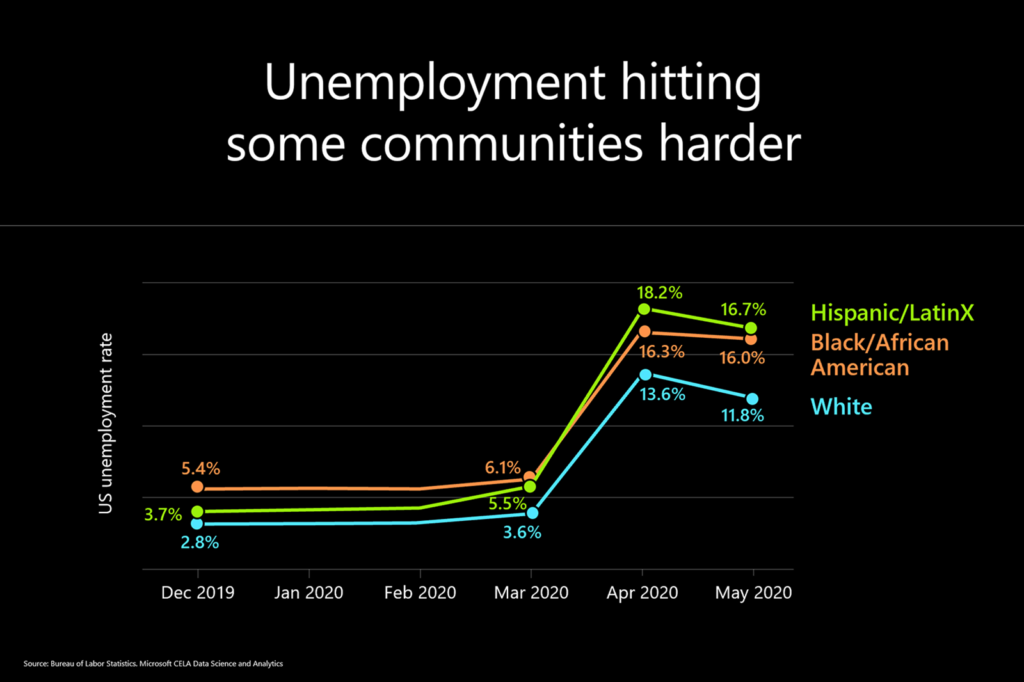
The employment of American women has also been impacted disproportionally by the COVID-19 pandemic. Unemployment rates among women, which has hovered with or edged below men’s unemployment rates, soared to more than 16%, almost 3 percentage points higher at the April peak.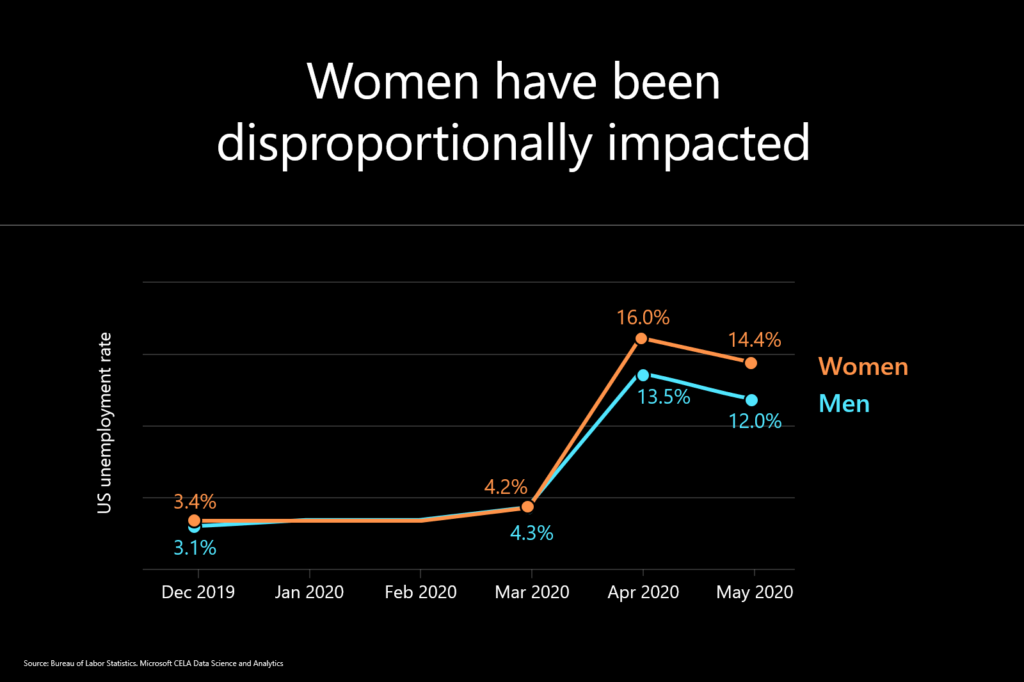
The challenges ahead reach beyond the immediate pandemic. Crises have a way of accelerating trends already in motion, and the COVID-19 pandemic has proven no exception. Our data shows that two years’ worth of digital transformation have been concentrated into the past two months. By one account, the final weeks of March alone witnessed as much broadband traffic growth as would be expected in a full year.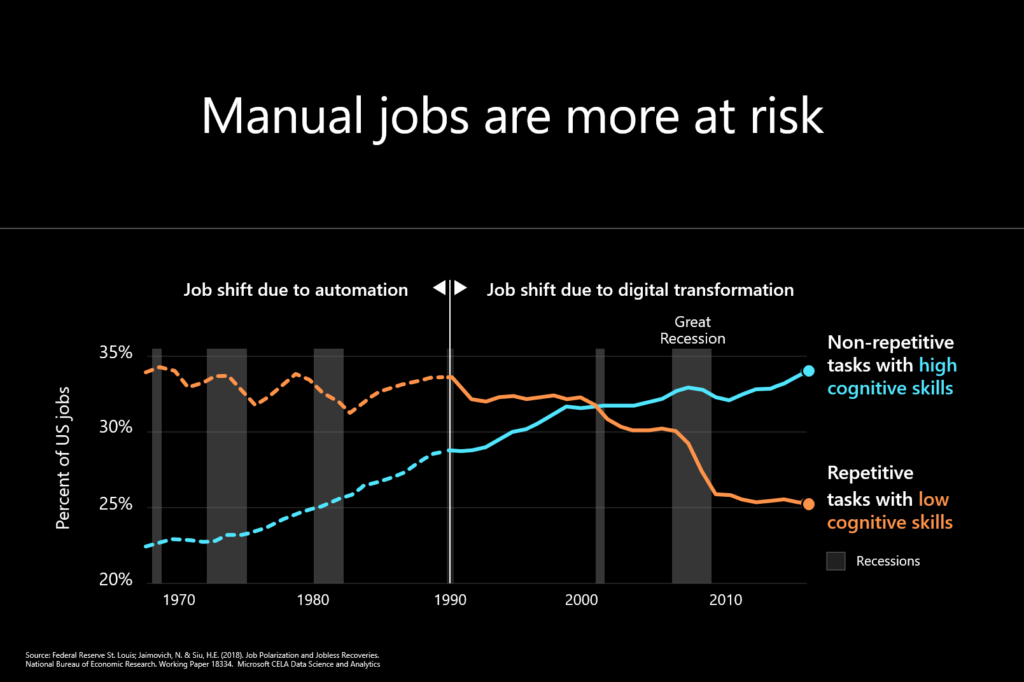
The pandemic has shined a harsh light on what was already a widening skills gap around the world – a gap that will need to be closed with even greater urgency to accelerate economic recovery. This longer-term disconnect between supply and demand for skills in the labor market appears to be driven by three primary long-term factors: (1) the rapid emergence of AI-powered technologies that are propelling a new era of automation; (2) the growing need for technological acumen to compete in a changing commercial landscape; and (3) the drop-off in employer-based training investments over the past two decades. Navigating these challenges to close the skills gap will require a renewed partnership between stakeholders across the public, private, and nonprofit sectors.
As we look to the future, we can draw insights from recessions in the past. Although recent recessions differed in their causes, each followed a trend of shedding low-skilled jobs and gradually replacing them with less automatable roles. In the late 1960s, roles that involved repetitive tasks involving manual work made up 34% of all jobs. These have been easier to automate, and as a result these jobs have now shrunk to 26% of all jobs. By contrast, jobs involving heavy cognition and problem-solving have simultaneously risen from 22% to 34%.
This pattern is poised to repeat itself, with an added emphasis on a jobs recovery that requires an increasing focus on digital skills. There are two reasons this appears likely.
First, in the shorter-term COVID-19 will continue to lead to unprecedented reliance on digital skills. In many situations, some workers may spend several months or longer in a “hybrid economy,” where some will be in the workplace while others continue to work from home. The shorter-term “hybrid economy” is a more digital economy. With continued consumer and employee reliance on almost “remote everything,” we can expect digitization of the economy to continue to advance at an accelerated speed. And as companies respond to a recession by increasing efficiency, this need for digital transformation will increase even further.
Second, the economic recovery will take place amid the longer-term and already-unfolding wave of automation based on the new technologies that underpin what some have called the Fourth Industrial Revolution. Over the next five years, we estimate that the global workforce can absorb around 149 million new technology-oriented jobs. Software development accounts for the largest single share of this forecast, but roles in related fields like data analysis, cyber security, and privacy protection are also poised to grow substantially.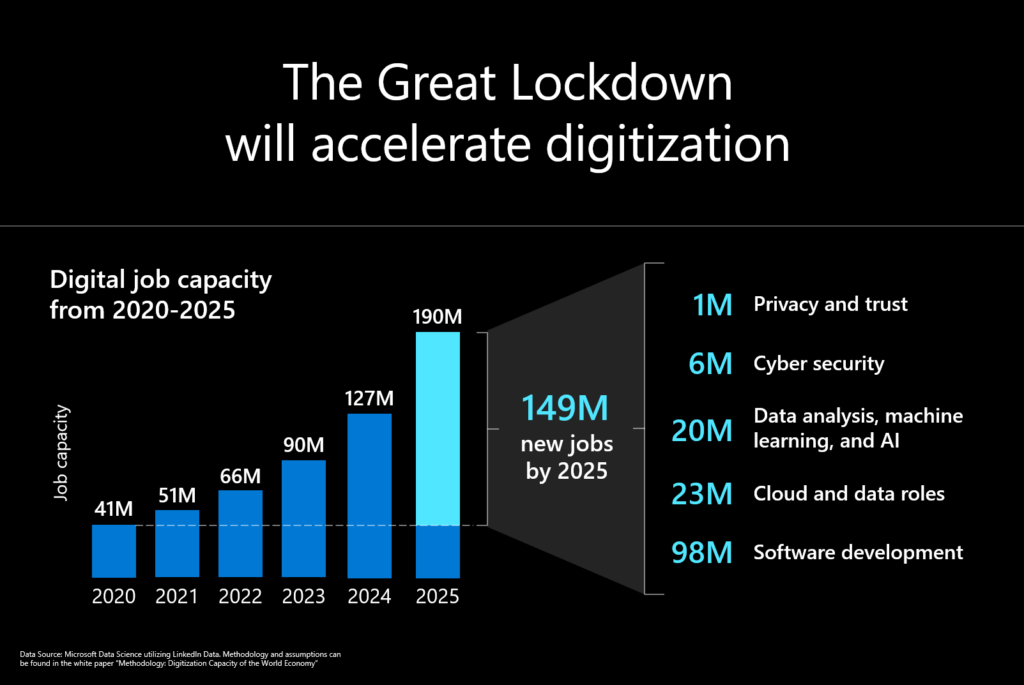
Of course, the magnitude and mixture of job growth will vary by country, industry, and sector. Although the impact will not be distributed evenly, digital transformation will touch virtually every corner of the global workforce — from food production (324,000 new jobs) to healthcare (2 million) and the automotive industry (6 million).
All this is made more urgent because of a challenge that has been two decades in the making, namely the decline and then stagnation in employer investments in training. Employer investments in training grew substantially throughout the 1980s and 1990s, as personal computers and the internet reshaped the world’s workplaces. This trend ceased around the turn of the century, as the dot-com recession and 9/11 marked the start of a nearly decade-long decline in employer-based investment in training.

Since 2008, the downward trend in employer-paid training has given way to a decade of stagnation, both in North America and around the world – notwithstanding a small spike in the wake of the Great Recession. Alarmingly, the trend of the past few years appears to be slightly negative. This contraction occurred despite the fact that the U.S. economy, which accounts for just under half of the global training market, was enjoying an unprecedented period of growth, and technological advances were beginning to reshape the modern workplace yet again.
Exacerbating the challenge is the fact that existing training is not reaching the populations who need it most. On-the-job training far outpaces distance learning and other alternative modes, limiting options for prospective employees. Perhaps more significantly, on-the-job training is more than two times as prevalent among workers who are already in higher-skilled roles, leaving those in more automatable positions even more vulnerable to displacement.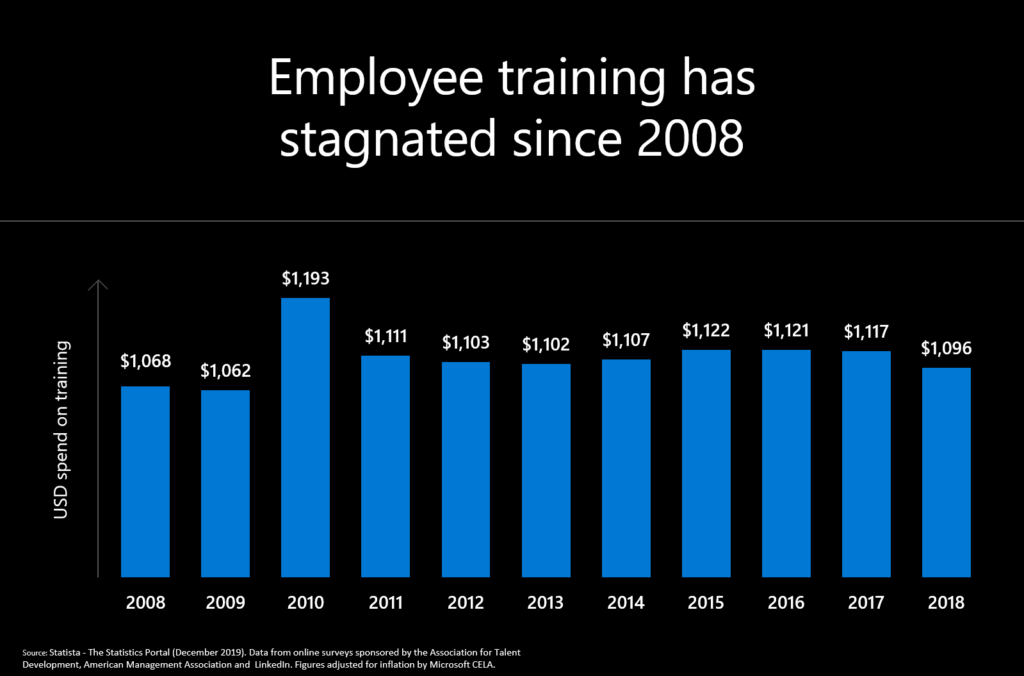
Digital technologies will be key to narrowing the divide, not only because they can expand the reach and accessibility of training, but because proficiency in these tools is in top demand. In a recent survey of American workers by Pew Research Center, for instance, 85% of respondents cited digital skills as either extremely important or very important to succeeding in today’s workplace.
But technology is only a means to an end, not an end in itself. The same Pew survey also observed that 85% of respondents regarded “soft” skills like collaborating with others and communicating effectively as highly important. In other words, people-oriented “success skills” remain as essential as ever – perhaps even more so given their durability at a time when technology continues to evolve at breakneck speed. Although technology companies have an important role to play in helping close the skills gap, success will take a concerted effort among employers, nonprofits, governments, and other stakeholders. The task calls for renewed partnerships and redoubled investments in skills, ensuring that training reaches the broadest group of people with the greatest needs.
A principled approach
As we have with our work to protect privacy, security, and environmental sustainability, we’ve concluded that the global skills challenge calls for a principled response. As a company, we’ll base our efforts on six key elements:
What we are launching today
Today’s global skills initiative is based on months of planning across Microsoft to provide meaningful help to 25 million people globally by the end of 2020. Our activities will be focused on three areas:
Several years ago, LinkedIn operationalized the world’s first Economic Graph to track workforce trends and provide a window into emerging skills gaps. The Economic Graph is a digital representation of the global economy based on more than 690 million professionals, 50 million companies, 11 million job listings, 36,000 defined skills, and 90,000 schools. In short, it is all the data on LinkedIn and shows available jobs, their required skills, and the existing skills job seekers have.
The Economic Graph also makes it possible to spot in-demand skills, emerging jobs, and global hiring rates. These insights help connect LinkedIn members to better opportunities and assist governments and organizations as they create economic opportunity for the global workforce.
As part of this new initiative, LinkedIn is sharing free, real-time labor market data and skills insights to help governments, policymakers and business leaders understand what’s happening in their local labor markets: what companies are hiring, the top jobs companies are hiring for and the trending skills for those jobs. This data can be accessed using a new interactive tool at linkedin.com/workforce. Data is available for more than 180 countries and regions (150+ cities, 30+ countries). Users can search by country or region and download the data sets.
We have also used the Economic Graph as a critical planning resource for today’s skills initiative, by identifying the key jobs and horizontal skills that are most widely in demand and creating learning paths for these via LinkedIn Learning. Using this data, we identified 10 jobs that are in-demand in today’s economy and are well positioned to continue to grow in the future. These 10 jobs were identified as having the greatest number of job openings, have had steady growth over the past four years, pay a livable wage, and require skills that can be learned online.
Much of our skills work is targeted at providing people with the skills for these disciplines.
To help people pursue jobs in these areas, we are making LinkedIn Learning paths aligned with each of these roles available free of charge through the end of March 2021. Each learning path includes a sequence of video content designed to help job seekers develop the core skills needed for each role. Each learning path is currently available in English, French, Spanish, and German.
LinkedIn Learning’s library for each learning path also includes collaborative courses, all taught by industry-expert instructors, allowing individuals to move through content and demonstrate their learning with a certificate of completion. Covering a broad range of skills from entry-level digital literacy to advanced product-based skills for technology roles, these role-based learning paths provide numerous opportunities for people along a learning continuum to reskill and upskill. We believe these are the types of resources that can place in-demand roles within reach of millions of job seekers.
In addition to these LinkedIn Learning paths, we are offering through Microsoft Learn free and in-depth technical learning content that also supports these roles. For roles that are more technical in nature, job seekers can go deeper on specific role-based Microsoft technologies with Microsoft Learn modules, gaining the most in-demand skills on widely used technologies.
We will also enable job seekers pursuing developer roles to access the GitHub Learning Lab to practice their skills. GitHub Learning Lab is a bot-based learning tool that uses repositories to teach technology, coding, Git, and GitHub via real-life, demo-based modules. This means that as job seekers engage in learning paths, they will have the opportunity to practice newly acquired skills by completing realistic projects in a personalized GitHub repository.
To provide people with easier access to the soft skills needed to pursue a new job, we are offering free access to four horizontal LinkedIn Learning paths. These are:
Finally, we are committed to developing and making available new courses and content that will focus on the skills needed to develop, deploy, and use technology in a responsible way. We recognize that issues such as privacy, security, digital safety, and the responsible application of artificial intelligence will continue to become even more important in the months and years ahead. We are committed to leading on these issues, not only for our own technologies but in assisting others to master needed skills as well.
Today’s initiative also aims to help job seekers demonstrate their skills to potential employers. This part of our initiative has multiple parts.
First, we will offer low-cost access to industry-recognized Microsoft Certifications based on exams that demonstrate proficiency in Microsoft technologies. We are making exams for these Microsoft Certifications available at a significantly discounted fee of $15 available to those who self-attest that their employment has been impacted by COVID-19. This represents a large discount on the price of exams that typically cost more than $100. We are committed to supporting the integrity of certifications by enabling proctoring safely in an online setting that is accessible from anywhere. The $15 fee will be paid to and will enable third parties to scale to meet the potential surge in examination resources and will support the integrity of the certification by enabling proctoring via a safe, online setting that is accessible from anywhere. We will also work with governments, nonprofits, foundations, and other private sector partners if they wish to absorb this third-party cost.
Participants will have the ability to schedule an exam from September to the end of the year, and exam takers will have until Dec. 31, 2021 to complete the exam. This will provide access to the exams that provide five fundamentals certifications and eight role-based certifications. These will include:
Learning paths and certification exams were initially available in English, French, German, Spanish, Japanese, simplified Chinese, and Korean. Learning paths are also now available in Portuguese.
We have found that these certifications are a powerful asset for job seekers and those looking to advance in an existing role. For example, in Global Knowledge’s 2019 IT Skills and Salary Report, more than half of IT decision-makers surveyed believe the main benefit of certified individuals is their ability to close organizational skills gaps seen in an everchanging technology environment. It also showed certifications helped make hiring easier, helping job seekers stand out. Among other things, these certifications, as well as completion of a learning path on LinkedIn Learning, can be added to an individual’s LinkedIn profile.
We are also making available tools to help individuals identify and pursue potential jobs. This includes a recently developed job interview preparation-feature, powered by MSFT-AI, to prepare and practice for job interviews. It also includes a new feature we are announcing today called #OpenToWork, which enables job seekers to surface to employers the roles for which they would like to be considered. Through a simple LinkedIn profile photo frame, #OpenToWork enables job seekers to let employers and the LinkedIn network know they are actively seeking a new opportunity, indicate the type of job they are looking for, express their needs for support, and get help from the LinkedIn community to find new opportunities.
We believe the strength of these resources is their comprehensive nature. To help people find and navigate all of our offerings, we have made all of these resources accessible from a single location: opportunity.linkedin.com. A job seeker or anyone looking to develop these on-demand skills can start here and will be guided through the learning paths based on the roles in which they are interested.
In addition, Microsoft and LinkedIn will continue to provide on-ramps for people from nontraditional backgrounds to successfully transition from learning skills to landing a job. This will include the Microsoft Software & Systems Academy, or MSSA, which provides transitioning U.S. service members and veterans with technology skills. It also includes Leap, which Microsoft launched in 2015 to recruit, develop, upskill non-traditional talent, and create a connection to employability in the tech industry. And it includes REACH, which is a multi-year engineering apprenticeship program at LinkedIn.
Supporting these offerings with cash grants to nonprofits
While all these tools, training, and certifications will be available online to millions of people in multiple languages, we recognize the need to supplement them with additional services and support. That’s why we will provide $20 million in financial grants, plus technical support, to nonprofit organizations around the world.
In part this will enable nonprofits to translate these resources into additional languages and to localize and tailor the learning content. These groups will also provide and support teachers and facilitators to help learners complete learning pathways and certification, and provide connections to wrap-around supports, coaching, and mentoring. We expect these grants will enable the nonprofits to reach 5 million unemployed workers, with a focus on particularly vulnerable groups. This includes people with disabilities, people from low-income communities, and people from diverse backgrounds that are underrepresented in tech, including women and underrepresented minorities.
We are launching this initiative globally with several highly-regarded nonprofit partners, including:
Although this is a global initiative, it’s important to take special steps to make digital skills more accessible to communities of color in the United States. We are focusing on community-based nonprofits, which are local organizations created to address the unique needs of the people living in a community. They are often the most trusted and effective at driving positive impact. However, data has shown that there are disparities in the funding provided to community-based nonprofits serving in communities of color and led by people of color.
This needs to change. Therefore, as a part of this skills initiative, Microsoft will dedicate support to community-based nonprofit organizations working to increase skill development and economic opportunities for communities of color, especially Black and African American communities. We will provide $5 million in cash grants to community-based nonprofit organizations that are led by and serve communities of color in the United States. This summer, we will publish additional information on this opportunity and will select organizations for this funding by fall of this year. We recognize that this is but a small part of the long overdue investment needed to address historical racial inequities in our society. We look forward to partnering with communities and other like-minded individuals and organizations to use our voice and resources to advocate for change to support communities of color.
Using our voice on public policy issues
We are committed to sharing data and what we learn from this initiative with governments around the world. In addition, we will advocate for public policy innovations that we believe can help accelerate essential skills needs and opportunities. We plan to address three priorities:
One creative example comes from Canada, where workers who risk displacement in an economic downturn are encouraged to develop individual training plans ranging from upgrading skills in current jobs to preparing for promotions and even training for jobs outside the company. This “Work-Sharing (WS)” program helps employers and employees avoid layoffs when there is a temporary reduction in the normal level of business activity beyond the control of an employer. It provides income support to employees eligible for employment insurance benefits who work a temporarily reduced work week while their employer recovers. WS is a three-party agreement involving employers, employees and Service Canada. Employees must agree to a reduced work schedule and to share the available work for a specified time. The impacted employees are compensated with salary for participation in skills enhancement training, whether on-the-job or at off-site courses, during the days/hours missed because of participation in the WS program.
Good examples are plentiful. They include work in New Zealand, where the government has invested approximately $1 billion to make vocational training courses free for all ages over the next two years. In the United States, the Pledge to America’s Workers American Workforce Policy Advisory Board, established by the White House, is developing proposals focused on investments in learning pathways, skills-based hiring, and the modernization of education and training to accelerate reskilling and facilitate innovation in workforce development. Other examples include programs in countries such as Singapore and France to create Lifelong Learning Accounts or similar mechanisms that would allow individual employees, employers and, in some models, the public sector, to invest in training for individuals.
COVID-related stimulus spending creates an important opportunity to pursue these opportunities further. As the European Commission has recently recognized, a “Next Generation EU” recovery package should address the importance of digital skills. To improve and adapt skills, knowledge and competences, the commission will come forward with a Skills Agenda for Europe and an updated Digital Education Action Plan.
Coming next: A new learning app in Microsoft Teams
The programs we are launching today are focused on helping job seekers. We have a broader vision for skills. We believe we need a connected “system of learning.” Central to this vision is a recognition that employers have a vital role to play in helping their employees to skill and re-skill. We know that employers need additional tools and resources to help here. As we have talked with our customers, we have heard some key themes:
Just as companies today have a system of engagement for customers with CRM technology and a system of record with ERP, they will need a system of learning. This will need to provide a continuous feedback loop between the work, skills and learning required to succeed at the task at hand, as well as the credentials to accelerate career advancement.
To support this, we are developing and will preview a new learning app in Microsoft Teams later this year, to bring learning into the natural flow of work. People are already using Microsoft Teams for meetings, chat, calling, collaboration, and business processes, and we are planning to extend that to include learning. The Teams learning app will allow employers to integrate world-class content from LinkedIn Learning, Microsoft Learn, a customer’s own content, and other content providers all in one place, ranging from instructor-led training to shorter, micro-learning content. The app will empower managers to assign and track learning progress and enable employees to have conversations around the content while also earning certifications and recognition for their new skills. Whether a new employee is onboarding, a manager is looking to sharpen a team’s skills, or a first-line worker is in the field needing immediate training, this new app will create a seamless experience for employees to learn in the flow of work.
Looking forward: A foundation for the skills and jobs of the future
As this detailed description makes clear, we are launching today the most comprehensive approach we have ever undertaken to meet the digital skilling needs of individuals and employers alike. We believe we can provide meaningful help to more than 25 million people globally in the coming months.
But in many ways, our ambitions are larger than this. For every part of Microsoft, including LinkedIn and GitHub, this marks a new beginning that will build on everything we have today and a new wave of technology innovation to come. We believe we can combine the best in technology with stronger partnerships with governments and nonprofits. Together we can better serve people, filling jobs and creating opportunities for individuals around the world. We should all aspire to turn a year that had a bleak beginning into a decade that has a bright finish. We bring a long-term determination and a commitment to do our part.
Watch the announcement event here and visit this site for more information.
*******
About LinkedIn Learning
LinkedIn Learning is an online educational platform that helps people discover and develop business, technology-related, and creative skills through expert-led course videos. With a catalogue of over 16,000 courses, and 60+ new courses released every week, LinkedIn Learning provides high-quality, relevant and up-to-date courses taught by real-world practitioners, located across the globe. Drawing on insights from millions of members, LinkedIn Learning personalizes course recommendations at scale and surfaces relevant learning content to each employee based on their connections.
About Microsoft Learn
Microsoft Learn is a free, interactive, hands-on training platform that helps people develop in-demand technical skills related to widely used Microsoft products and services including Azure, Microsoft 365, Power Platform, Microsoft Dynamics, and more.
Microsoft Learn combines short step-by-step trainings, browser-based interactive coding and scripting environments, and task-based achievements to help learners advance their technical skills and prepare for Microsoft Certifications. With millions of registered learners, Microsoft Learn offers over 225 learning paths, more than 1,000 modules, and is localized in dozens of languages. Microsoft Learn is great for individual users to advance their skills, as well as organizations that want to create curated employee training paths.
Tags: Brad Smith, education, Global skills initiative, Training
Follow us:


